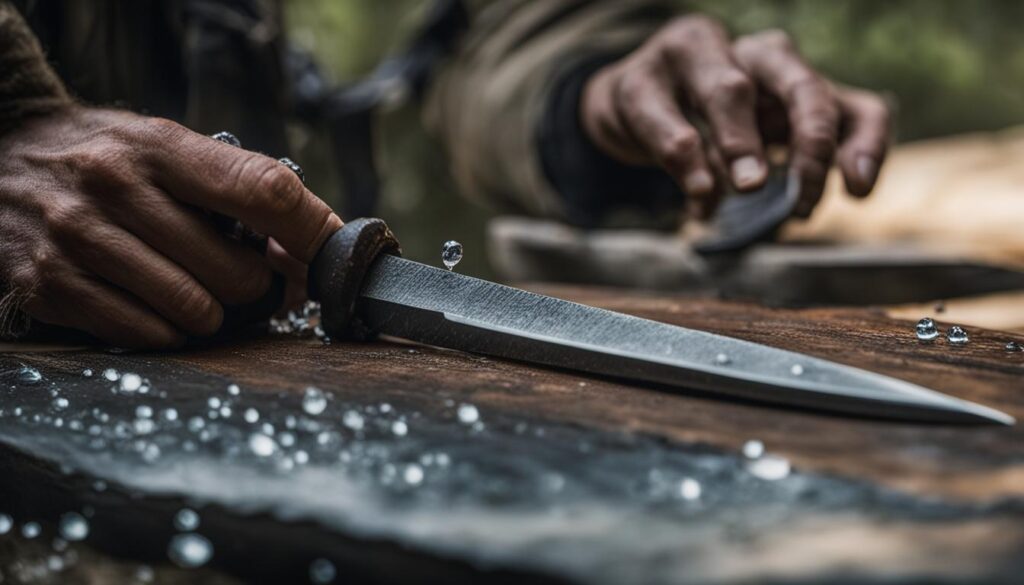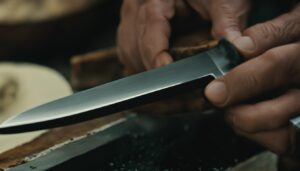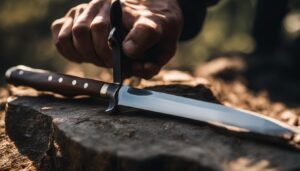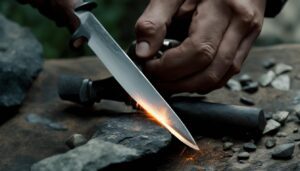Maintaining the sharpness of hunting knives is crucial for hunters. Dull blades can make hunting and outdoor activities more challenging and even dangerous. In this guide, I will provide you with all the information you need to achieve razor-sharp blades using hunting knife sharpening kits. We will explore different types of knives and their impact on the sharpening process. Additionally, we will discuss the various types of sharpening tools available, such as sharpening stones, honing rods, electric sharpeners, pull-through sharpeners, and guided sharpening systems. Preparing your hunting knife for sharpening is essential, and we will cover the necessary steps to ensure the best results.
Key Takeaways:
- Regularly sharpening your hunting knife is essential for optimal performance and safety during outdoor activities.
- Understanding the different types of knives and their sharpening requirements is crucial for achieving razor-sharp blades.
- Sharpening tools such as sharpening stones, honing rods, electric sharpeners, pull-through sharpeners, and guided sharpening systems offer various options for maintaining blade sharpness.
- Properly preparing your hunting knife before sharpening, including cleaning the blade and determining the correct sharpening angle, is crucial for achieving the best results.
- Consistent maintenance and care, along with the use of honing rods and proper storage, will help keep your hunting knife sharp for longer periods of time.
How the Type of Knife Affects the Sharpening Process
The type of hunting knife you have plays a significant role in the sharpening process. Each type of knife requires specific techniques to achieve optimal sharpness. Let’s explore how different hunting knife types, such as drop point, clip point, gut hook, Bowie, and skinning knives, impact the sharpening process.
Drop point knives feature a curved edge and are best sharpened using a sharpening stone or honing rod with a rounded edge. This allows for consistent angle maintenance during sharpening. On the other hand, clip point knives with straight edges can be sharpened using straight-edged sharpening stones or honing rods.
Gut hook knives have a unique blade shape with a hook at the edge. They require special attention during sharpening, with the hook’s edge sharpened separately. When it comes to Bowie knives, their longer and curved blade poses a challenge, necessitating the use of longer sharpening stones or honing rods.
Lastly, skinning knives typically have narrow blades and are easier to sharpen, although they may require more frequent sharpening due to their use in tasks such as skinning game. Understanding the characteristics of each knife type is crucial for applying the appropriate sharpening techniques.
Table: Summary of Sharpening Techniques for Different Knife Types
| Knife Type | Recommended Sharpening Tool |
|---|---|
| Drop Point Knife | Sharpening Stone or Honing Rod with Rounded Edge |
| Clip Point Knife | Straight-Edged Sharpening Stone or Honing Rod |
| Gut Hook Knife | Sharpen Hook Edge Separately |
| Bowie Knife | Longer Sharpening Stone or Honing Rod |
| Skinning Knife | Sharpening Stone or Honing Rod |
Understanding the sharpening techniques for different knife types allows you to maintain razor-sharp blades and optimize the performance of your hunting knives.
Different Types of Sharpening Tools
In the world of hunting knife sharpening, there are various types of tools available to help you achieve razor-sharp blades. Understanding the different options and their benefits can greatly enhance your sharpening experience. Here, I will explore the most common types of sharpening tools used by hunters:
1. Sharpening Stone
Sharpening stones, also known as whetstones, are a classic and versatile tool for sharpening hunting knives. They come in different grits, allowing you to choose the level of abrasiveness for your specific needs. Sharpening stones are ideal for achieving a precise edge and maintaining control over the sharpening process.
2. Honing Rod
A honing rod is another popular tool for maintaining the sharpness of hunting knives. It is used to realign the blade’s edge, ensuring it stays straight and sharp between sharpenings. Honing rods are particularly useful for touch-ups and quick maintenance, as they can be easily carried in your hunting gear.
3. Electric Sharpener
If you prefer a quick and efficient sharpening process, an electric sharpener might be the right choice for you. Electric sharpeners use abrasive belts or discs to remove dull areas from the blade, providing a fast and precise result. They are suitable for hunters who value convenience and time-saving features.
4. Pull-Through Sharpener
For those seeking a portable and user-friendly sharpening tool, a pull-through sharpener is a popular option. It features pre-set sharpening angles and a guided slot for the blade. Pull-through sharpeners are easy to use, making them ideal for beginners or hunters who prefer a hassle-free sharpening experience.
5. Guided Sharpening System
If you’re new to sharpening or want a foolproof method, a guided sharpening system is worth considering. These systems provide a consistent angle throughout the sharpening process, ensuring an even edge. With guidance and built-in features, guided sharpening systems are excellent for beginners and those who value precision.
No matter which sharpening tool you choose, it’s essential to select the appropriate one based on your skill level, preferences, and the type of knife you have. Remember to follow the manufacturer’s instructions and practice proper technique to achieve the best results.

Preparing Your Hunting Knife For Sharpening
Properly preparing your hunting knife before sharpening is essential to achieve the best results. Here are the key steps to follow:
Cleaning the Blade
Start by thoroughly cleaning the blade of your hunting knife. Use a mild soap and warm water to remove any dirt, debris, or residue. Gently scrub the entire blade and dry it completely before proceeding. Cleaning the blade ensures that there are no particles that could interfere with the sharpening process.
Checking for Damage
Next, carefully inspect the blade for any signs of damage, such as nicks or chips. Run your finger along the blade’s edge to detect any imperfections that may need to be smoothed out before sharpening. It’s important to address any damage before sharpening to ensure a clean and even edge.
Determining the Sharpening Angle
The sharpening angle is crucial for achieving a razor-sharp edge. You can determine the correct sharpening angle by referring to the manufacturer’s recommendations or using a sharpening guide. It’s important to maintain a consistent angle throughout the sharpening process to ensure an even edge on both sides of the blade.
Choosing a Sharpening Method
There are various sharpening methods available, such as sharpening stones, honing rods, electric sharpeners, pull-through sharpeners, and guided sharpening systems. Choose the method that best suits your skill level and the type of knife you have. Each method has its own advantages and may require different techniques.
By properly preparing your hunting knife for sharpening, you’ll set yourself up for success in achieving a razor-sharp blade. Take the time to clean the blade, check for any damage, determine the correct sharpening angle, and choose the appropriate sharpening method. Following these steps will ensure that you have a well-prepared knife ready for sharpening.
How To Sharpen A Hunting Knife Using A Whetstone
In this section, I will guide you through the step-by-step process of sharpening your hunting knife using a whetstone. This sharpening technique is ideal for achieving razor-sharp blades and maintaining the performance of your knife. Follow these instructions carefully to ensure the best results and prolong the lifespan of your hunting knife.
Holding the Sharpening Stone
Begin by securely holding the sharpening stone on a flat surface. Make sure it doesn’t move or slide during the sharpening process. This stability is crucial for maintaining a consistent angle and getting an even sharpening result.
Applying Pressure
Place the knife blade against the whetstone at the desired sharpening angle. Apply light and steady pressure as you move the blade back and forth in a sweeping motion. It’s important to maintain the same angle throughout the sharpening process. This consistent pressure and motion will help create a uniform edge along the entire length of the blade.
Creating a Burr
Continue sharpening, alternating between sides, and increasing the pressure slightly with each pass. This repeated motion will gradually remove the dullness from the blade and create a burr on one side. The burr is a thin ridge of metal that signifies the sharpening progress and indicates that the edge is getting sharper.
Removing Burrs and Honing the Edge
Once the burr has formed, it’s time to remove it. Use a honing rod to gently realign and smooth the edge. Start with light strokes, gradually increasing the pressure as you go. This honing process helps refine the blade’s sharpness and removes any remaining burrs. After honing, the edge should feel smooth and sharp to the touch.
Blade Care
After sharpening your hunting knife, it’s important to properly care for the blade. Clean off any metal shavings or debris using a soft cloth or brush. Wipe the blade dry to prevent moisture or rust formation. Consider applying a thin coat of oil to further protect the blade from corrosion. Proper blade care will help maintain the sharpness and longevity of your hunting knife.


How To Keep Your Hunting Knife Sharp For Longer Periods of Time
Proper maintenance plays a crucial role in keeping your hunting knife sharp for extended periods. Here are some essential practices to follow:
Using a Honing Rod
A honing rod is a valuable tool for maintaining the sharpness of your hunting knife between sharpenings. Regularly running the blade against the honing rod helps realign the edge and removes any small nicks or bends that may occur during use. Remember to match the rod’s material with the hardness of your knife blade for optimal results.
Proper Storage
Properly storing your hunting knife is essential for preserving its sharpness. A leather sheath or a wooden block provides excellent protection and keeps the knife away from moisture, humidity, and extreme temperatures. Avoid storing your knife in damp environments, as this can lead to rust and corrosion.
Avoiding Misuse
Using your hunting knife for tasks it’s not intended for can quickly dull the blade. Avoid using it for prying, chopping, or any other activities that put excessive strain on the edge. Instead, use the knife for its intended purpose, such as skinning, cutting, or slicing, to maintain its sharpness for longer periods.
Regular Sharpening
To ensure your hunting knife stays sharp, regular sharpening is necessary. The frequency of sharpening depends on how often you use the knife and the tasks you perform. By sticking to a consistent sharpening schedule using the appropriate sharpening tools, such as a sharpening stone or an electric sharpener, you can maintain a razor-sharp edge on your hunting knife.
| Knife Maintenance Practices | Benefits |
|---|---|
| Using a honing rod | Preserves and realigns the blade’s edge |
| Proper storage | Protects the knife from moisture and temperature extremes |
| Avoiding misuse | Prevents premature dulling of the blade |
| Regular sharpening | Maintains a razor-sharp edge |
The Art of Stropping: The Final Step for Razor-Sharp Blades
When it comes to achieving razor-sharp blades, the art of stropping is the final step in the sharpening process. Stropping involves using a leather strop and a micro abrasive compound to refine the knife’s edge to perfection. By drawing the knife backward across the strop, maintaining a similar angle to the one used during sharpening, you can achieve a polished and razor-sharp edge.
To start the stropping process, firmly hold the leather strop on a flat surface. Place the blade against the strop, making sure to maintain the same angle as when sharpening. Slowly draw the knife backward, applying light pressure and moving it in a smooth, sweeping motion. This motion helps to round the edge and remove any remaining burrs, giving the blade a polished finish.
In some cases, a dry strop may need to be revived before starting the stropping process. To revive a dry strop, apply a thin layer of petroleum jelly to the leather surface. This helps to condition and lubricate the strop, making it more effective in the stropping process. Additionally, applying a micro abrasive compound to the strop can further enhance the stropping results.
Assessing the sharpness of the blade can be done through a paper test or using a Blade Edge Sharpness Tester (BESS). The paper test involves slicing through a sheet of paper using the freshly stropped blade. If the blade effortlessly glides through the paper with a clean cut, it is considered sharp. The BESS tester, on the other hand, measures the downward force required to cut through a standardized piece of filament, providing a numerical value to assess the sharpness.
| Stropping Technique | Leather Strop | Micro Abrasive Compound | Maintaining the Angle | Reviving a Dry Strop | Assessing Sharpness |
|---|---|---|---|---|---|
| Draw the knife backward across the strop | Use a leather strop for optimal results | Apply a micro abrasive compound to refine the edge | Maintain the same angle as when sharpening | Revive a dry strop with petroleum jelly | Assess sharpness through a paper test or BESS tester |
Conclusion
Achieving razor-sharp blades with hunting knife sharpening kits is essential for hunters. Properly maintaining and sharpening our knives will enhance our performance and ensure our safety in the field. By understanding the different types of knives, sharpening tools, and techniques, we can embark on a successful sharpening journey.
Regular maintenance and care are key. We must use honing rods to keep our knives sharp between sharpenings. Proper storage in a dry place, away from humidity and extreme temperatures, is crucial to prevent damage. And let’s not forget to avoid misusing our knives for tasks they’re not intended for, like prying or chopping. These simple steps will go a long way in maintaining our hunting knives.
The art of stropping provides the final touch in achieving razor-sharp blades. With a leather strop and a micro abrasive compound, we can refine our knife’s edge to perfection. Taking the time to assess the sharpness of our knives through paper tests or using a BESS tester is important to ensure optimal performance in the field.
By following the techniques and tips outlined in this guide, we can take our hunting experiences to the next level. So let’s keep our hunting knife sharpening kits handy, prioritize knife maintenance, and enjoy the benefits of razor-sharp blades. Happy hunting!
FAQ
Why is maintaining the sharpness of hunting knives important?
Dull blades can make hunting and outdoor activities more challenging and even dangerous.
What types of knives require specific sharpening techniques?
Drop point knives, clip point knives, gut hook knives, Bowie knives, and skinning knives all have unique sharpening needs.
What are the different types of sharpening tools available?
Sharpening stones, honing rods, electric sharpeners, pull-through sharpeners, and guided sharpening systems are all popular options.
What steps should I take to prepare my hunting knife for sharpening?
Cleaning the blade, checking for damage, determining the sharpening angle, and choosing the appropriate sharpening method are all essential preparatory steps.
How do I sharpen a hunting knife using a whetstone?
The technique involves holding the sharpening stone securely, applying light pressure, creating a burr, removing the burrs, honing the edge, and taking care of the blade.
How can I keep my hunting knife sharp for longer periods of time?
Using a honing rod, storing the knife properly, avoiding misuse, and regularly sharpening the blade are all key maintenance practices.
What is the art of stropping, and how does it contribute to razor-sharp blades?
Stropping involves using a leather strop and a micro abrasive compound to refine the knife’s edge. It helps maintain the angle and can be used to assess sharpness.
What is the importance of hunting knife sharpening kits and proper knife maintenance?
Hunting knife sharpening kits and proper maintenance are crucial for achieving razor-sharp blades and ensuring optimal performance and safety.





